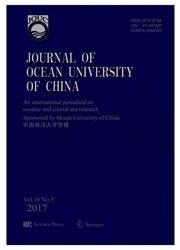

 中文摘要:
中文摘要:
海啸造成的灾害与损失并非都与淹没有关,特别是港口中海啸诱导的强流会对船只及海事设施产生重要的影响及损害.由于海啸流观测数据稀缺及海啸诱导涡流机制的不确定性,过去60年海啸科学主要集中于对海啸波特征及淹没过程的研究与分析,海啸流模拟及验证工作开展较少,导致对海啸流基本特征及其造成灾害现象的曲解.开展海啸诱导的涡流研究及预警服务显得尤为重要及紧迫.考虑快速海啸预警需要,综合对比海啸诱导涡流的物理框架及模型方法,探索兼顾效率与计算精度的海啸流模拟方法是本文的核心工作及出发点.通过分析浅层湍流相干结构(TCS)产生的主要物理耗散机制,确定了考虑2D水平耗散机制的非线性浅水方程可用于海啸涡流的模拟分析.基于高精、高分辨率有限体积模型Geoclaw建立了三个精细化的港口海啸流模型,模型分辨率为5m.利用基于海啸浮标反演的海啸源模型作为初始条件,模拟分析了日本东北地震海啸在远场的海啸波流特征.海啸波流特征模拟结果与观测吻合较好,结果可信.对比发现:波驱动的自由表面流,小的位相或波幅误差就会导致大的流速误差,流的模拟和预报相对波幅来说更具挑战性.研究了海啸波流能量在港池中的分布特征,得到:港池入口及防波堤两端常被强流控制,具有极高的危险性;相对于波幅的空间变化,海啸流具有更强的空间敏感性;所建立的高分辨率海啸模型模拟再现了日本海啸在近场的涡旋结构,给出了与观测基本一致的涡流特征.最后,引入海啸流危险等级标准,分析了港口海啸流危险性等级分布、船只疏散的安全深度及回港的时间周期.针对港口、海湾同时考虑海啸波流特征的海啸预警与评估对于港口应急管理者科学决策具有重要意义.
 英文摘要:
英文摘要:
Tsunamis not only lead to flooding but also cause strong flows within semi-closed basins and give rise to some practical concerns.Vessels and maritime facilities were vulnerable to tsunami current in harbors,which often occurred many hours after the initial tsunami arrival.Due to limitation of field observation and lack of knowledge on the generation of vortex,the study on tsunami over the past sixty years mainly focus on the characteristics of tsunami waves and its inducing flooding.There is few study on the tsunami-induced flow,which results in incomplete understanding of tsunami waves and their related disaster.It is very important and urgent to carry out the research and services on strong current induced by tsunamis.This paper compares the excitation mechanism and simulation methods,and tries to get the balance between accuracy and efficiency for tsunami-induced flow simulation.By analyzing the main physical dissipation mechanism of shallow turbulent coherent structures(TCS),the nonlinear shallow water equations considering the 2D horizontal dissipation mechanism can be used to simulate tsunami-induced vortex flows.Three highresolution harbors models were set up based on the finite volume model Geoclaw.The resolution of the three models is 5meters.Far-field Tsunami wave and current characteristics from Tohokuoki earthquake are analyzed relied on the tsunami source model estimated by tsunami dart buoy inversion.The simulation results of the tsunami wave and current characteristics are in good agreement with the observations.It is further shown that tsunami-induced flow is more sensitive,and small error for the free surface and the phase can induce larger error for the current flow.The accurate simulation for tsunami-induced flow is more challenging. In present work, the energy distribution characteristics of tsunami wave and current in harbors are investigated.Relative to spatial variability of wave amplitude,tsunami current has much greater spatial sensitivity,and it is strong around the harbor entrance
 同期刊论文项目
同期刊论文项目
 同项目期刊论文
同项目期刊论文
 期刊信息
期刊信息
